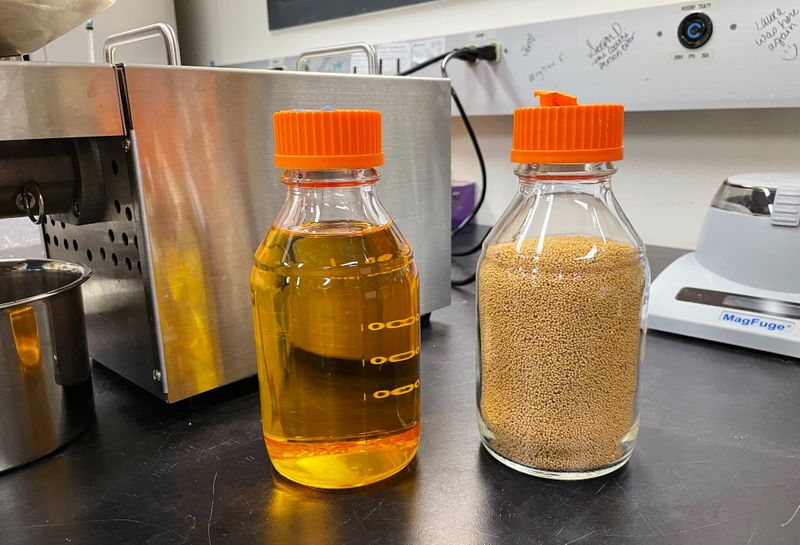By Karl Plume and Rod Nickel
ARENZVILLE, Illinois (Reuters) - A disparate group met in an Illinois field on a windy spring morning to study a crop some call stinkweed.
Botanists, businessmen, farmers and federal lawmakers, they all gathered to peer at the waist-high plant usually considered a pest and uprooted on sight because of its foul odor, toxicity and the grim taste it leaves in the milk of grazing cattle.
This was a new version created by gene-editing, though. The compound that made it stinky and poisonous in large doses was suppressed, leaving an oilseed crop that its backers say could help the world transition to a lower-carbon economy via biofuels, as well as meet growing demand for livestock feed.
The group of about 25 people came to survey one of the first large-scale plantings of covercress, the genetically tweaked version of stinkweed, or pennycress.
It is among a handful of crops that could provide alternatives to the world's most widely used oilseeds, soybeans and canola, crushed to produce oil used in cooking and biofuels, plus high-protein meal for pigs and chickens.
"How often is a brand new oilseed introduced?" Brian Engel, director of biofuels at agribusiness giant Bunge (NYSE:BG) Ltd, told Reuters after visiting the field in Arenzville.
"We're going to do everything we can to get that seed crushed and get the oil and meal into the marketplace."
Supplies of soybeans and canola are dwindling rapidly, with not enough produced to keep up with global demand for food and feed products, let alone greener fuels like renewable diesel. Prices have rocketed, contributing to food inflation around the world.
The new candidates, which include carinata and camelina - known as false flax - also represent potential "cover crops", off-season sources of revenue for farmers to help insulate them from market downturns.
"The solution to this feedstock problem is going to come from a whole lot of sources," said Jerry Steiner, executive board chairman at startup CoverCress Inc, which is selling the edited stinkweed and has raised $22 million in funding, including from big players like Bayer AG (DE:BAYGN) and Bunge.
The company expects plantings of up to 1,000 acres this fall, swelling up to 3 million acres by 2030, saying gene-editing is more accepted by consumers than genetic modification, which introduces new genes.
LOW-CARBON ECONOMY
But it's early days for the new players.
While demand for oilseeds is rising, it is tough for niche crops to break through as they must meet tough regulatory standards, for biofuels in particular, and be produced at scale to be commercially viable. Scaling up production can take years, requiring financial commitment and risk for both the developers and the farmers who grow the new crops.
Yet the companies behind covercress and carinata spy an opportunity as governments from Canada and California to Europe impose mandates to reduce the carbon-intensity of fuel in an effort to meet stringent climate goals.
Crops like covercress are particularly appealing because they soak up carbon dioxide in the off-season, when fields would otherwise be fallow.
This new reality is putting pressure on refiners to produce fuel from crops instead of fossil fuels and, as a consequence, biofuel demand is forecast to grow exponentially in coming years as more renewable diesel production capacity comes online.
A soaring global appetite for animal feed and vegetable oil has already whittled down stockpiles of soybeans and canola. Farmers say they can't significantly expand plantings because they must rotate crops to keep soils healthy.
Global supplies of soybeans, by far the world's most widely used oilseed, are set to hit a five-year low of 86.5 million tonnes by September, while demand is expected to reach a record high, the U.S. Department of Agriculture says. Demand from soybean processors that crush it into oil and meal has swelled 45% over the past decade, while production has grown just 37%.
In the United States, demand for soybean oil could outstrip production by up to 8 billion pounds annually within two years if just half the announced refinery expansion projects are completed, according to BMO Capital Markets.
A consequent surge in prices for soybeans and canola has helped drive the United Nation's broader food price index to its highest level since 2014, stinging developing countries.
'IT IS A RARE CROP'
This year, for the first time, Argentine farmer Horacio Merialdo plans to sow carinata, a towering plant crowned with yellow flowers, another new oilseed hoping to make it big.
Merialdo said he would plant carinata in the off-season from growing soybeans, and its deep roots would carve channels that allow rain to seep deep into the soil, and stop weeds flourishing, benefiting the later soybean crops.
He is using seeds supplied by Nuseed, part of Australian agrichemical company Nufarm (OTC:NFRMY) Ltd, which launched commercial sales last year of carinata in Argentina.
Those plantings are currently less than 100,000 hectares, but the company expects them to double within two years and rise exponentially in subsequent years as it expands production to the United States, Paraguay and Uruguay.
"We experienced the industry repeatedly asking us to go faster, so we've ramped up those plans," said Alex Clayton, Nuseed's business development lead for carinata.
Yet the perils of plowing his own, experimental furrow are not lost on Merialdo.
"The prospects are good but the risk is that it is a rare crop, with a single price maker and a single buyer," said Merialdo, who farms in the Pampas grain-belt town of Suipacha, in Buenos Aires province. "So there is less certainty."
'I CAN'T PRODUCE ENOUGH'
Nuseed currently sells all carinata production to Saipol, France's largest biodiesel producer.
Saipol itself is also working on developing new crops, such as the flowering oilseed camelina, to produce biodiesel alongside the fuel it makes largely from rapeseed, a close cousin of canola, said CEO Christophe Beaunoir.
Unlike some new oilseeds like covercress, which have not previously been cultivated, farmers already grow camelina in small quantities for use in fish rations and in health products for dogs and horses.
Smart Earth Seeds, a Canadian seed developer and producer of camelina oil, said the crop was now catching the demand wave lifting soybean and canola prices, more than tripling the company's sales this year.
"I just can't produce enough," CEO Jack Grushcow said.
REFINERS: CAUTIOUS INTEREST
Yet it is a long road for new hopefuls.
"The trick will be whether we can get enough farmers to be interested and comfortable," CoverCress CEO Mike DeCamp said.
Whole seeds will be sold as poultry feed, with crushing into oil and meal expected to begin in 2025, he added.
Niche crops' use in biofuels is so far limited. The U.S. Environmental Protection Agency said it was reviewing one fuel facility's request for approval of carinata as a credit-generating feedstock under the Renewable Fuel Standard. Camelina is already approved.
With production of such oilseeds currently small, refiners are cautious about building plants that rely on them.
Covenant Energy will produce renewable diesel from canola at its planned Saskatchewan refinery, but the facility will also be able to use carinata and camelina, CEO Josh Gustafson said.

Joel MacLeod, CEO of Tidewater (NYSE:TDW) Midstream and Infrastructure, is planning to produce 3,000 barrels per day of renewable diesel and renewable hydrogen in total at its refinery in Prince George, British Columbia.
"On camelina and carinata, we definitely have an interest," he said. "But we can't have massive swings in our blend, month over month."
